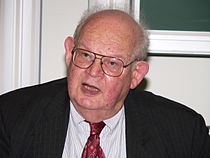Benoît Mandelbrot
| Benoit Mandelbrot | |
|---|---|

At a TED conference in 2010.
|
|
| Born |
20 November 1924 Warsaw, Poland |
| Died | 14 October 2010 (aged 85) Cambridge, Massachusetts, United States |
| Residence |
|
| Nationality |
|
| Fields | |
| Institutions | |
| Alma mater |
École Polytechnique California Institute of Technology University of Paris |
| Doctoral students | |
| Known for | |
| Influences | Szolem Mandelbrojt |
| Influenced | Nassim Nicholas Taleb |
| Notable awards |
2003 Japan Prize 1993 Wolf Prize 1989 Harvey Prize 1986 Franklin Medal 1985 Barnard Medal |
| Spouse |
Aliette Kagan
married 1955–2010 (his death) |
 |
|
|
|
Benoit B. Mandelbrot (20 November 1924 – 14 October 2010) was a Polish-born, French and American mathematician with broad interests in the practical sciences, especially regarding what he labeled as "the art of roughness" of physical phenomena and "the uncontrolled element in life." He referred to himself as a "fractalist". He is recognized for his contribution to the field of fractal geometry, which included coining the word "fractal'", as well as developing a theory of "roughness and self-similarity" in nature.
In 1936, while he was a child, Mandelbrot's family migrated to France. After World War II ended, Mandelbrot studied mathematics, graduating from universities in Paris and the United States and receiving a master's degree in aeronautics from the California Institute of Technology. He spent most of his career in both the United States and France, having dual French and American citizenship. In 1958, he began a 35-year career at IBM, where he became an IBM Fellow, and periodically took leaves of absence to teach at Harvard University. At Harvard, following the publication of his study of U.S. commodity markets in relation to cotton futures, he taught economics and applied sciences.
Because of his access to IBM's computers, Mandelbrot was one of the first to use computer graphics to create and display fractal geometric images, leading to his discovering the Mandelbrot set in 1979. He showed how visual complexity can be created from simple rules. He said that things typically considered to be "rough", a "mess" or "chaotic", like clouds or shorelines, actually had a "degree of order." His math and geometry-centered research career included contributions to such fields as statistical physics, meteorology, hydrology, geomorphology, anatomy, taxonomy, neurology, linguistics, information technology, computer graphics, economics, geology, medicine, physical cosmology, engineering, chaos theory, econophysics, metallurgy and the social sciences.
...
Wikipedia
